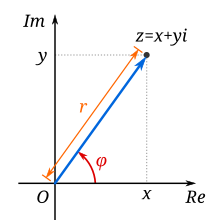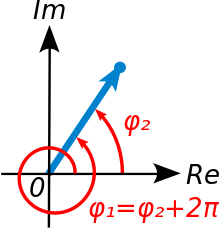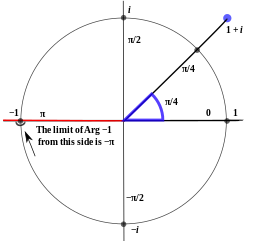
In mathematics (particularly in complex analysis), the argument of a complex number z, denoted arg(z), is the angle between the positive real axis and the line joining the origin and z, represented as a point in the complex plane, shown as in Figure 1. By convention the positive real axis is drawn pointing rightward, the positive imaginary axis is drawn pointing upward, and complex numbers with positive real part are considered to have an anticlockwise argument with positive sign.
When any real-valued angle is considered, the argument is a multivalued function operating on the nonzero complex numbers. The principal value of this function is single-valued, typically chosen to be the unique value of the argument that lies within the interval (−π, π]. In this article the multi-valued function will be denoted arg(z) and its principal value will be denoted Arg(z), but in some sources the capitalization of these symbols is exchanged.
In some older mathematical texts, the term "amplitude" was used interchangeably with argument to denote the angle of a complex number. This usage is seen in older references such as Lars Ahlfors' Complex Analysis: An introduction to the theory of analytic functions of one complex variable (1979), where amplitude referred to the argument of a complex number. While this term is largely outdated in modern texts, it still appears in some regional educational resources, where it is sometimes used in introductory-level textbooks.
Definition

An argument of the nonzero complex number z = x + iy, denoted arg(z), is defined in two equivalent ways:
- Geometrically, in the complex plane, as the 2D polar angle from the positive real axis to the vector representing z. The numeric value is given by the angle in radians, and is positive if measured counterclockwise.
- Algebraically, as any real quantity such that for some positive real r (see Euler's formula). The quantity r is the modulus (or absolute value) of z, denoted |z|:
The argument of zero is usually left undefined. The names magnitude, for the modulus, and phase, for the argument, are sometimes used equivalently.
Under both definitions, it can be seen that the argument of any non-zero complex number has many possible values: firstly, as a geometrical angle, it is clear that whole circle rotations do not change the point, so angles differing by an integer multiple of 2π radians (a complete circle) are the same, as reflected by figure 2 on the right. Similarly, from the periodicity of sin and cos, the second definition also has this property.
Principal value

Because a complete rotation around the origin leaves a complex number unchanged, there are many choices which could be made for by circling the origin any number of times. This is shown in figure 2, a representation of the multi-valued (set-valued) function , where a vertical line (not shown in the figure) cuts the surface at heights representing all the possible choices of angle for that point.
When a well-defined function is required, then the usual choice, known as the principal value, is the value in the open-closed interval (−π, π] radians, that is from −π to π radians excluding −π radians itself (equiv., from −180 to +180 degrees, excluding −180° itself). This represents an angle of up to half a complete circle from the positive real axis in either direction.
Some authors define the range of the principal value as being in the closed-open interval [0, 2π).
Notation
The principal value sometimes has the initial letter capitalized, as in Arg z, especially when a general version of the argument is also being considered. Note that notation varies, so arg and Arg may be interchanged in different texts.
The set of all possible values of the argument can be written in terms of Arg as:
Computing from the real and imaginary part
Main article: atan2If a complex number is known in terms of its real and imaginary parts, then the function that calculates the principal value Arg is called the two-argument arctangent function, atan2:
- .
The atan2 function is available in the math libraries of many programming languages, sometimes under a different name, and usually returns a value in the range (−π, π].
In some sources the argument is defined as however this is correct only when x > 0, where is well-defined and the angle lies between and Extending this definition to cases where x is not positive is relatively involved. Specifically, one may define the principal value of the argument separately on the half-plane x > 0 and the two quadrants with x < 0, and then patch the definitions together:
See atan2 for further detail and alternative implementations.
Realizations of the function in computer languages
Wolfram language (Mathematica)
In Wolfram language, there's Arg:
Arg
or using the language's ArcTan:
Arg
ArcTan is extended to work with infinities. ArcTan is Indeterminate (i.e. it's still defined), while ArcTan doesn't return anything (i.e. it's undefined).
Maple
Maple's argument(z) behaves the same as Arg in Wolfram language, except that argument(z) also returns if z is the special floating-point value −0..
Also, Maple doesn't have .
MATLAB
MATLAB's angle(z) behaves the same as Arg in Wolfram language, except that it is
Unlike in Maple and Wolfram language, MATLAB's atan2(y, x) is equivalent to angle(x + y*1i). That is, atan2(0, 0) is .
Identities
One of the main motivations for defining the principal value Arg is to be able to write complex numbers in modulus-argument form. Hence for any complex number z,
This is only really valid if z is non-zero, but can be considered valid for z = 0 if Arg(0) is considered as an indeterminate form—rather than as being undefined.
Some further identities follow. If z1 and z2 are two non-zero complex numbers, then
If z ≠ 0 and n is any integer, then
Example
Using the complex logarithm
From , we get , alternatively . As we are taking the imaginary part, any normalisation by a real scalar will not affect the result. This is useful when one has the complex logarithm available.
Extended argument
The extended argument of a number z (denoted as ) is the set of all real numbers congruent to modulo 2.
References
- ^ Weisstein, Eric W. "Complex Argument". mathworld.wolfram.com. Retrieved 2020-08-31.
- "Modulus and Argument". mas-coursebuild.ncl.ac.uk. Newcastle University. Retrieved 2025-01-05.
- "Modulus and Argument of a Complex Number". Byju's. Retrieved 18 January 2025.
- Dictionary of Mathematics (2002). phase.
- "Arg". Wolfram Language Documentation. Retrieved 2024-08-30.
- "Argument - Maple Help".
- "Phase angle - MATLAB angle".
- "Four-quadrant inverse tangent - MATLAB atan2".
- "Algebraic Structure of Complex Numbers". www.cut-the-knot.org. Retrieved 2021-08-29.
Bibliography
- Ahlfors, Lars (1979). Complex Analysis: An Introduction to the Theory of Analytic Functions of One Complex Variable (3rd ed.). New York;London: McGraw-Hill. ISBN 0-07-000657-1.
- Ponnuswamy, S. (2005). Foundations of Complex Analysis (2nd ed.). New Delhi;Mumbai: Narosa. ISBN 978-81-7319-629-4.
- Beardon, Alan (1979). Complex Analysis: The Argument Principle in Analysis and Topology. Chichester: Wiley. ISBN 0-471-99671-8.
- Borowski, Ephraim; Borwein, Jonathan (2002) . Mathematics. Collins Dictionary (2nd ed.). Glasgow: HarperCollins. ISBN 0-00-710295-X.
 .
. for some positive real r (see
for some positive real r (see 
 , where a vertical line (not shown in the figure) cuts the surface at heights representing all the possible choices of angle for that point.
, where a vertical line (not shown in the figure) cuts the surface at heights representing all the possible choices of angle for that point.

 .
. however this is correct only when x > 0, where
however this is correct only when x > 0, where  is well-defined and the angle lies between
is well-defined and the angle lies between  and
and  Extending this definition to cases where x is not positive is relatively involved. Specifically, one may define the principal value of the argument separately on the half-plane x > 0 and the two quadrants with x < 0, and then patch the definitions together:
Extending this definition to cases where x is not positive is relatively involved. Specifically, one may define the principal value of the argument separately on the half-plane x > 0 and the two quadrants with x < 0, and then patch the definitions together:



 extended to work with infinities.
extended to work with infinities.  if
if  .
.

 .
.




 , we get
, we get  , alternatively
, alternatively  . As we are taking the imaginary part, any normalisation by a real scalar will not affect the result. This is useful when one has the
. As we are taking the imaginary part, any normalisation by a real scalar will not affect the result. This is useful when one has the  ) is the set of all real numbers congruent to
) is the set of all real numbers congruent to  modulo 2
modulo 2